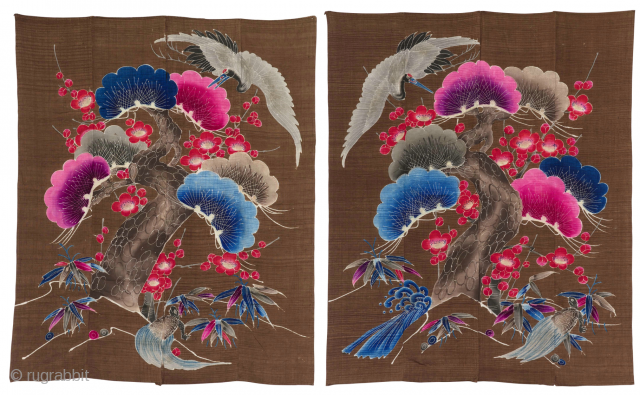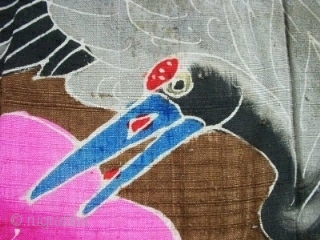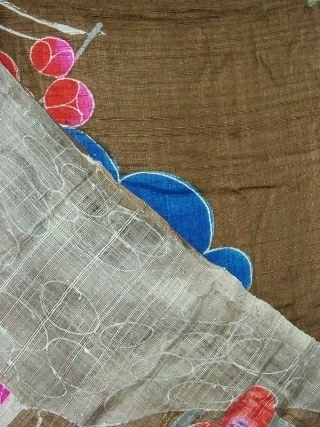Back
Rare Tsutsugaki Futonji Couple.
Meiji Period (circa 1890), 156x125cm and 156x124cm.
a complete representation of the symbols cards for the spouses, thus said Shochikubai and Tsurukame that in addition to the 'three friends Winter, and the crane, also includes the turtle with a long tail, a further symbol of longevity. Let us analyse more in detail the various components. The pine is an evergreen tree (which according to legend lives 1000 years), bamboo grows tall and strong but also flexible and does not break under the weight of snow, while the plum tree buds are the first who courageously make their way through ice and snow at the end of the long cold season, that’s why they are called 'three friends of winter' and have meaning auspicious. The crane in Japan is considered one of the most beautiful and graceful animals, but also associated with spirituality and kindness.
Many popular stories represent the crane as a heroine with such features. Together with the turtle, they are believed to be mythological creatures that live on both, Earth and paradise of immortal Taoists, whence association with longevity. What is more important for the newlyweds, however, is that the cranes are said to mate for life. There are several futonji showing such a composition, but this pair has a unique character: on the one hand colouring, which stands out on a lot of raw silk background, on the other hand that is in front of a spectacular set, and this has not to our knowledge an analogy in the literature.
Textile is tsumugi silk, with soft touch, and vivid and bold picture dyed with tsutsugaki technique. a fabulous tsutsugaki futonji couple.
price:
SOLD
- Home
- Antique Rugs by Region
- Category
- Profiles
- Post Items Free
- Albums
- Benaki Museum of Islamic Art
- Budapest: Ottoman Carpets
- Gulbenkian Museum
- Islamic Carpets. Brooklyn
- Islamic Textiles. Brooklyn
- Konya Museum: Rugs
- MKG, Hamburg
- MMA: Caucasian Carpets
- MMA: Mamluk Carpets
- MMA: Mughal Indian Carpets
- MMA: Ottoman Carpets
- MMA: Safavid Persian Carpets
- MMA: Turkmen Rugs
- McCoy Jones Kilims
- Ottoman textiles. Met
- Philadelphia Museum
- Rugs and Carpets: Berlin
- Seljuqs at the Met
- TIEM, Istanbul: Carpets
- V&A: Classical Carpets
- Vakiflar Carpets: Istanbul
- Baluch Rugs: Indianapolis
- Gallery Exhibitions
- Jaf an Exhibition
- Alberto Levi Gallery
- Andean Textile
- Christie's London: 2016
- Francesca Galloway
- HALI at 40
- ICOC Washington, DC 2018
- Jajims of the Shahsavan
- London Islamic Week April, 2018
- Mongolian Felts
- Navajo Rugs: JB Moore
- Persian Piled Weavings
- SF Tribal & Textile Art Show 2020
- SF Tribal 2019
- Sotheby's: C. Alexander
- Turkish Prayer Rugs
- Turkmen Main Carpets ICOC 2007










